The network automation market is estimated to be valued at USD 17.87 Billion in 2025 and is expected to reach USD 86.21 Billion by 2032, growing at a compound annual growth rate (CAGR) of 25% from 2025 to 2032.
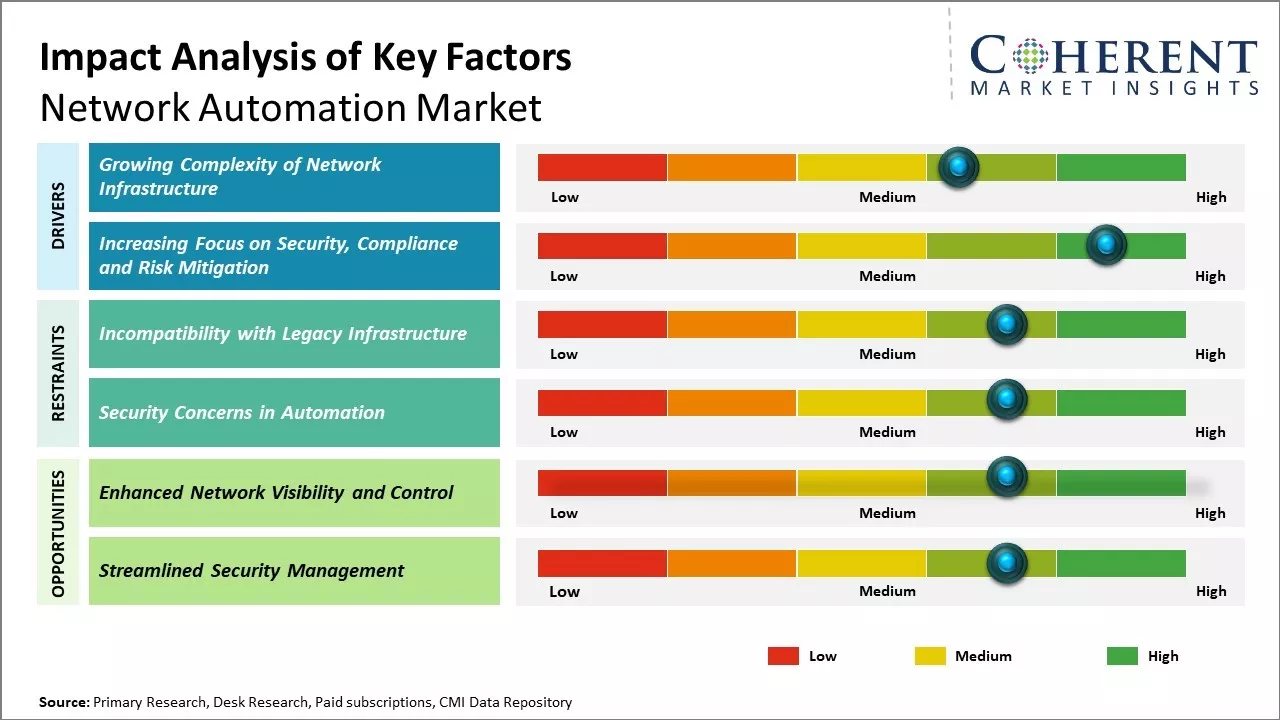
Discover market dynamics shaping the industry: Download Free Sample
The growing complexity of modern networks is driving the increased demand for network automation solutions. With rise in the remote work culture and digital transformation of enterprises, there is a need to streamline network operations and ensure optimum performance. Additionally, the shortage of networking skills is compelling organizations to adopt advanced automation tools that can simplify and optimize routine network tasks. The growing adoption of cloud, IoT, and 5G technologies is also creating the need for highly scalable and self-driving networks. This is expected to further fuel the adoption of network automation platforms and solutions in the coming years.
Drivers of the Market:
Growing Complexity of Network Infrastructure
With the rapid growth of digital technologies and connectivity, network infrastructures have become massively large, complex, and diverse in today's world. Almost everything and everyone is now connected over various types of networks and this trend of hyperconnectivity is expected to accelerate further with emerging technologies like IoT, 5G, and edge computing. However, scaling and managing these exponentially growing networks has become a herculean task for organizations. Traditional manual methods of network administration are unable to handle configurations, updates, and changes across thousands of devices and locations in real-time. Even small human errors can cause major disruptions. Moreover, as networking environments incorporate multiple hybrid cloud platforms, diverse operating systems, and a plethora of new devices, the complexity is rising manifold. This complexity reduces visibility, impacts compliance and security, and increases the risk of outages. Network automation solutions are helping organizations overcome these challenges by enabling centralized, programmable, and intelligent management of infrastructure at a large scale. Through continuous monitoring, auto-remediation of failures and standardized configurations, these solutions are improving reliability, agility and efficiency of networks while reducing manual intervention and costs. As networks continue expanding in size, diversity and business criticality, automated management will become an inevitable requirement for enterprises to stay ahead of this growing complexity.
For instance, in February 2023, Tech Mahindra utilized the netOps.ai network automation platform to enhance network operations efficiency for Telefónica Germany. Additionally, by updating Telefonica's Operations Support Systems (OSS) stack, Tech Mahindra assisted Telefonica in accelerating its transition to autonomous networks. The adoption of netOps.ai technology, automating the end-to-end Network Lifecycle, marked a significant improvement in operational KPIs through its "Continuous Insights & Intelligence (CI2F)" methodology.
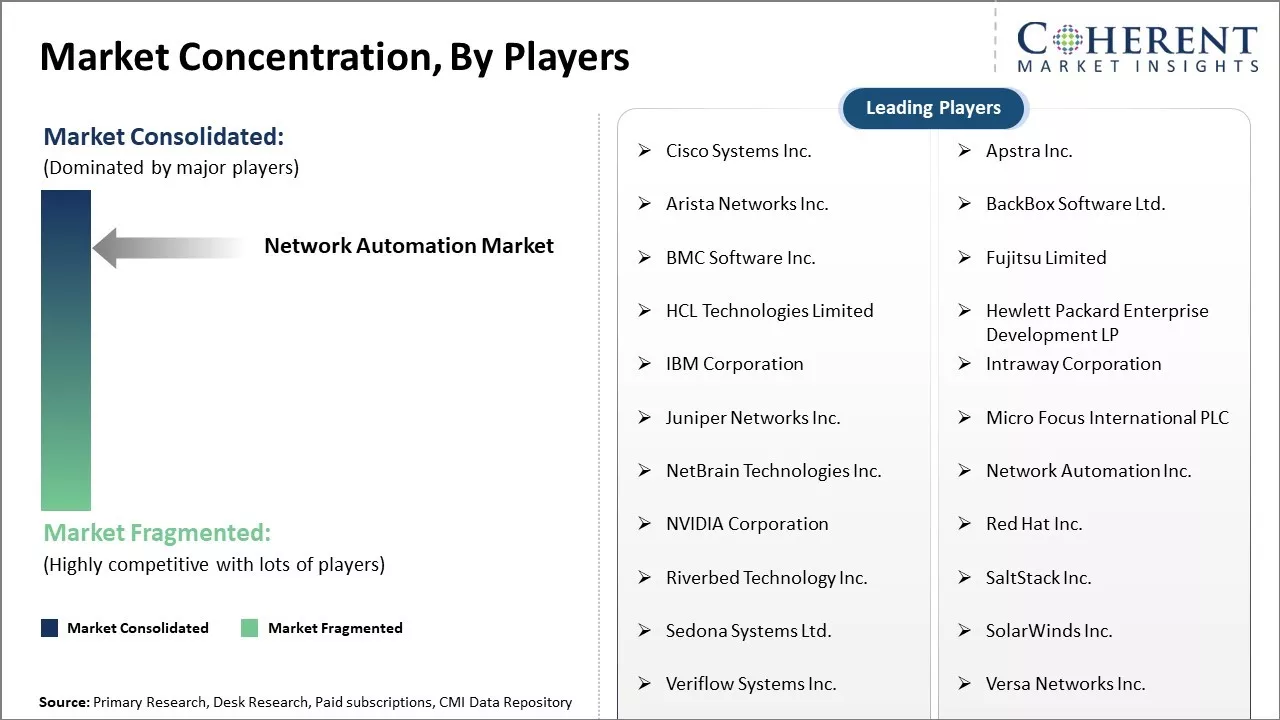
Get actionable strategies to beat competition: Download Free Sample
Increasing Focus on Security, Compliance, and Risk MitigationWith cyber threats and attacks rising exponentially, security has become a top priority and boardroom agenda for companies across all industries. Both compliance to regulations and risk mitigation have assumed critical importance. However, keeping networks secure at such massive scale with distributed devices and users remains a daunting task. Traditional security measures involving manual processes are unable to prevent, detect and respond to threats in real-time across hybrid IT environments spanning physical, virtual and cloud platforms. Network automation is enabling round-the-clock security through application of consistent configurations, control of access policies, automated vulnerability assessment, continuous monitoring of threats and auto-remediation of anomalies before they cause damage. It is helping improve change management for faster rollout of security updates. Analytics over telemetry data is further enhancing visibility and risk assessments. By reducing the attack surface and implementing predictive strategies, network automation is lowering security risks and assisting compliance audits. As regulations tighten and stakes rise with every breach, automation driven proactive security will see heightened focus and investment from enterprises and governments alike to strengthen resilience against cybercrimes.
For instance, the increasing network data traffic is evident in the May 2022 report by GSMA Association, stating a 21% hike in GSMA's network data traffic in 2021. Moreover, according to a 2022 report by Ericsson, the global mobile data traffic reached around 90 EB per month by the end of 2022, with projections of a fourfold increase to 325 EB per month by 2028. The surge in data traffic underscores the necessity for heightened utilization of network automation.
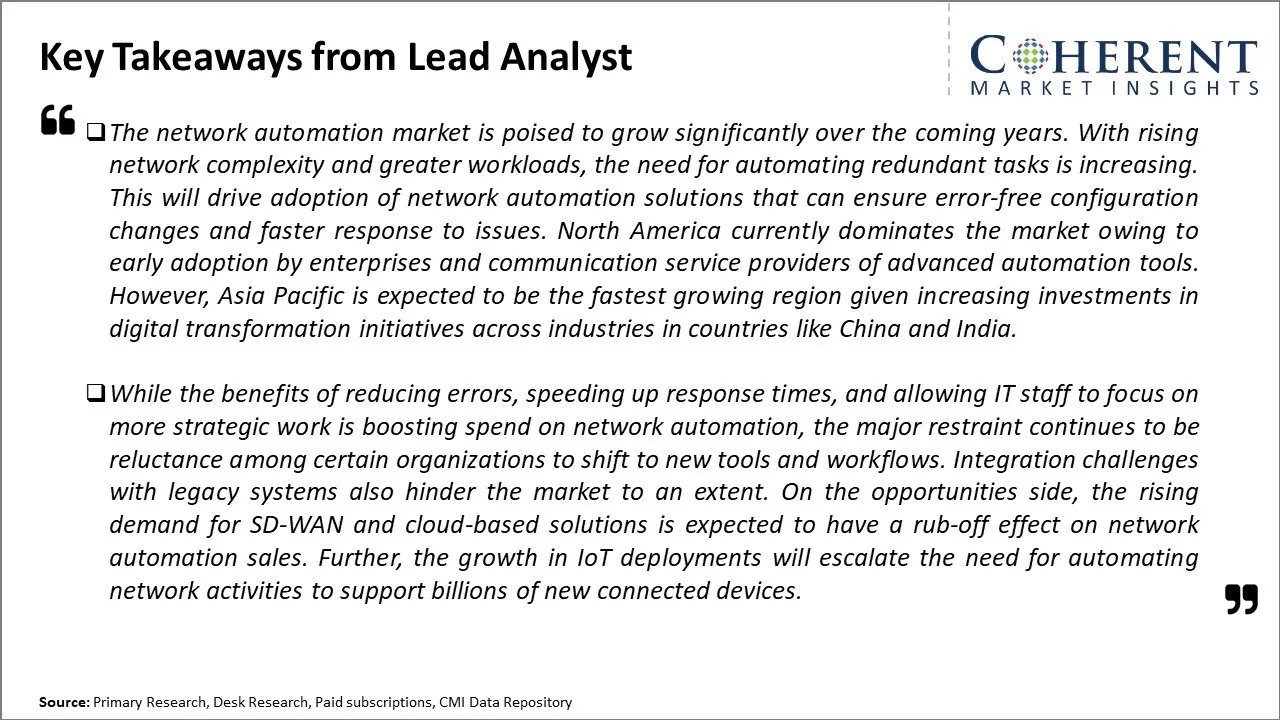
To learn more about this report, Download Free Sample
Market Challenges: Incompatibility with Legacy InfrastructureThe network automation market currently faces many challenges. Traditional network infrastructure with isolated systems and manual intensive processes have been slow to adopt new technologies. Legacy network devices pose integration challenges for network automation solutions. Further, shortage of skilled networking talent makes it difficult for organizations to build in-house automation capabilities, requiring extensive training and skill development. Security also remains a top concern as automated systems introduce new vulnerabilities that must be proactively addressed. Overall, overcoming organizational inertia to change and transform existing network operations presents a significant hurdle.
Market Opportunities: Enhanced Network Visibility and Control
As network complexity rises with borderless architectures, advanced threat landscapes and business critical applications, there is a growing need for centralized automation to gain visibility, improve compliance, and optimize operations.
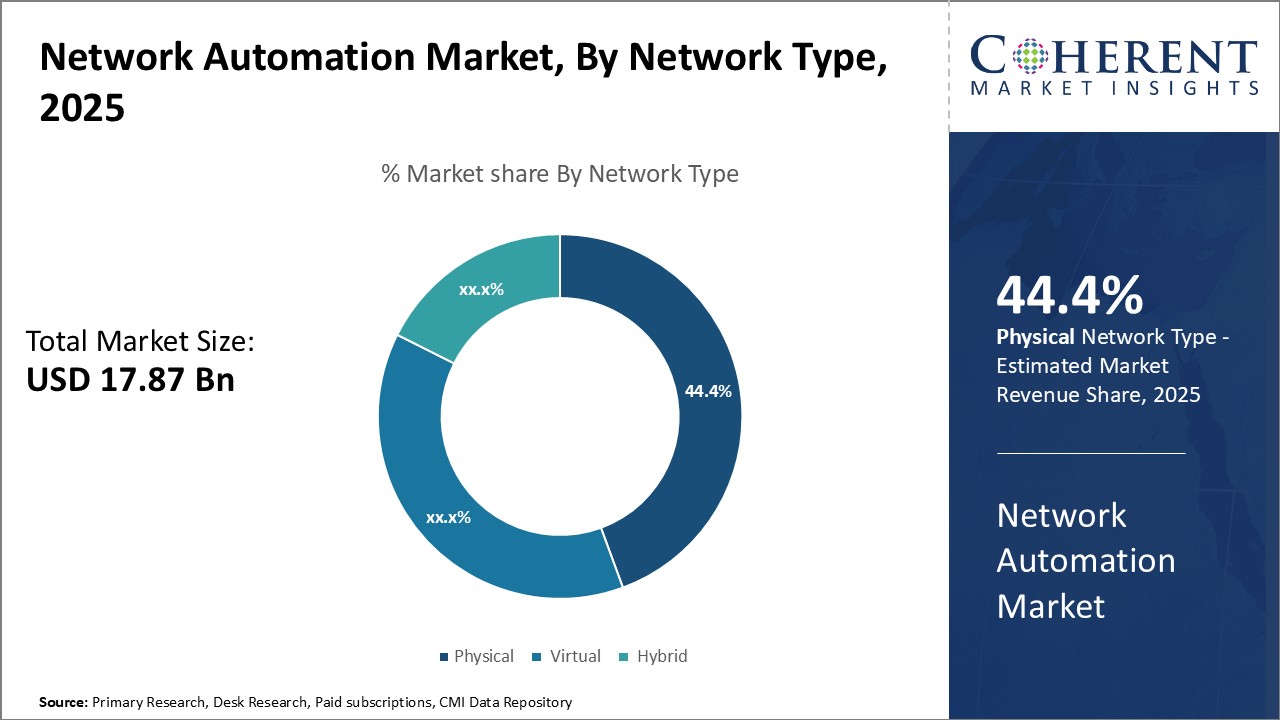
Discover high revenue pocket segments and roadmap to it: Download Free Sample
Insights, By Network Type- Network Infrastructure Requirements Drive Physical Segment AdoptionThe physical segment within the network type category is expected to contribute the highest share of 44.4% in 2025, owing to the need for control and management of physical network devices. Physical networks consist of network switches, routers, firewalls and other hardware located within an organization’s infrastructure that require setup, updating and ongoing maintenance. Automating the configuration and routine tasks associated with physical devices provides numerous benefits to network administrators. It allows for consistent implementation of policies and procedures across all physical assets. Network changes and expansions can be carried out in a centralized and automated manner, reducing manual errors. Performance monitoring and issue resolution is streamlined through automated alerts and diagnostic tools. Upgrades to new software or adding new physical devices is achieved quicker through network automation scripts and workflows. This significantly improves the efficiency of network operations teams and reduces costs long-term from wasted time and labor on repetitive mundane tasks. The complexities of large physical networks make automation virtually mandatory to effectively handle the scale and complex dependencies within enterprise environments. Overall, the need to centrally manage growing physical networks drives the bulk of demand within this segment.
Insights, By Service Type- Tools’ Dominance Due to Diverse Automation Requirements
The network automation tools segment is estimated to hold the largest share of 47.78% in 2025, due to the diverse set of automation needs across different network domains. Common tools sought by customers include network configuration management tools, firewall/security automation, network monitoring/assurance tools and cloud automation software. Configuration management tools allow templates to be created for consistent configurations of devices, interfaces, routing protocols etc., and speeding deployment of changes across 1,000s of devices. Security automation tools help configure many firewall rules in parallel and integrate with other systems like routers creating a synchronized security posture. Monitoring suites provide one place to set monitoring policies, collect metrics and generate reports/alarms to maintain high service levels. Cloud tools enable provisioning of new cloud resources, migrating workloads between public/private clouds through declarative templates. As networks grow in size and complexity, the number of tools required increases to automate various functional domains effectively. Also, best of breed functionality encourages procuring tools from different vendors. Overall, diverse automation needs ensure tools remain the primary choice over bundled alternatives in this evolving market landscape.
Insights, By Deployment Type- On-Premise Deployments Favored for Security and Control
The on-premise deployment method is estimated to hold the largest share of 61.79% in 2025, due to strong customer preferences around security and control. Several factors encourage on-premise installations, especially for critical network functions. Firstly, storing network configurations, credentials and associated intellectual property on-premise addresses security concerns around proprietary data residing outside the organization’s firewalls. Secondly, having network automation software and controllers locally provides full control over sensitive automation workflows and change management cycles that directly affect network uptime. Downtime of cloud-hosted automation utilities could potentially stall network operations until resolution. Lastly, on-premise solutions do not have vulnerabilities related to unpredictable wide-area network issues that could interfere with automation workflows. Some customers also prefer avoiding vendor lock-in through dependency on cloud-hosted SaaS versions. While hybrid and cloud-based options provide benefits like simplified upgrades and off-site redundancy, the sensitivities around network security and control make on-premise a leading choice, especially for larger deployments handling business-critical applications and data. This trend is expected to continue with security as the top consideration.
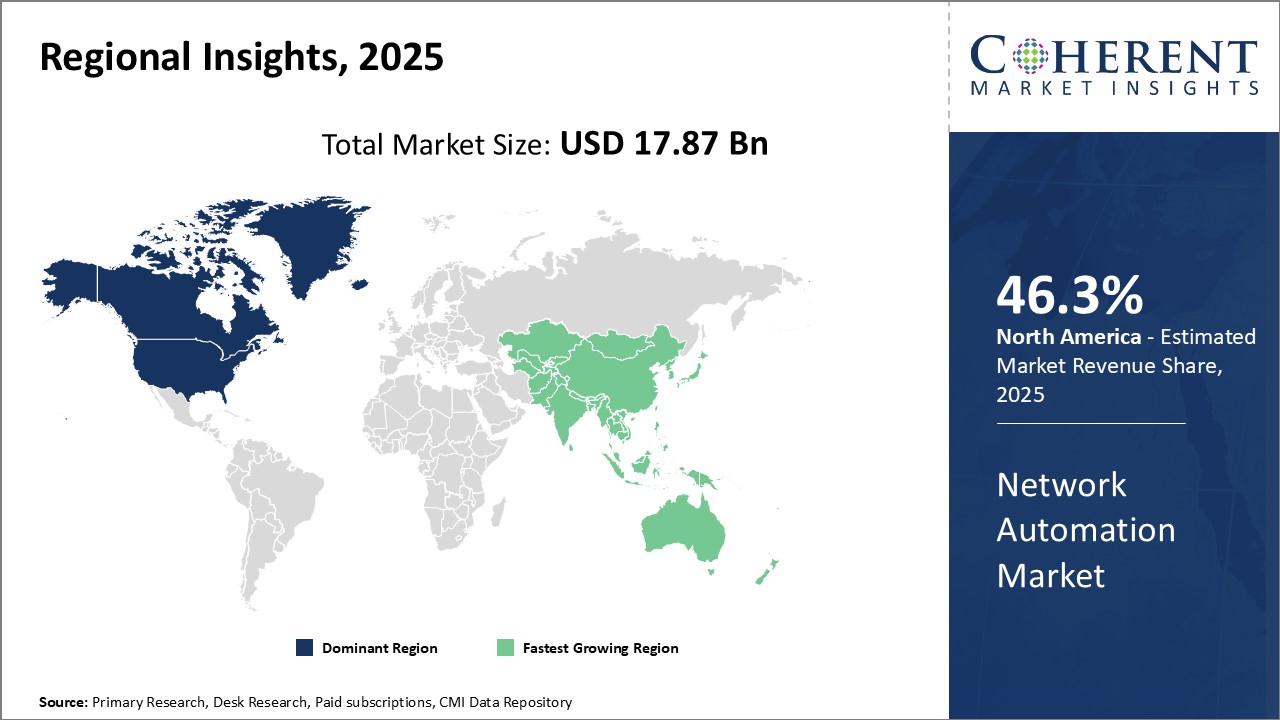
Need a Different Region or Segment? Download Free Sample
North America has established itself as the dominant player in the network automation market and is expected to hold the largest share of 46.3% in 2025. The region is home to several large technology companies that are at the forefront of innovating network automation solutions. These companies have made huge investments in research and development to develop cutting edge products and services. They also actively focus on automation to improve efficiency and reduce costs for their customers.
Further, many businesses in North America have widely adopted cloud, IoT, big data, and other emerging technologies in their operations. This has increased the network complexity multi-fold and driven the need for automation. There is a growing demand from both enterprise and communication service provider segments to automate routine network operations and activities. Organizations are increasingly relying on network automation to speed up deployments, improve uptime and reliability of networks.
Compared to other regions, Asia Pacific is witnessing the fastest growth in the network automation space and is estimated to grow at a CAGR of 29.42% in 2025. Rapid digital transformation of businesses and economy is happening across several developing nations in Asia Pacific. Countries like China, India, and others are focusing on connectivity infrastructure development through investments. 5G rollouts have begun and more networks are being deployed. This is resulting in more network complexities that require automation.
Further, a large IT services industry has emerged in Asia Pacific to cater to global clients. Outsourcing and offshoring models followed by companies, increases dependency on remote network management. Network automation solutions help improve visibility, control, and incident response times for providers operating in Asia Pacific. For network operators, automation offers Capex and Opex benefits through efficient operations. Their adoption is predicted to rise at an accelerated pace compared to mature markets.
Network Automation Market Report Coverage
| Report Coverage | Details | ||
|---|---|---|---|
| Base Year: | 2024 | Market Size in 2025: | USD 17.87 Bn |
| Historical Data for: | 2020 To 2024 | Forecast Period: | 2025 To 2032 |
| Forecast Period 2025 to 2032 CAGR: | 25.2% | 2032 Value Projection: | USD 86.21 Bn |
| Geographies covered: |
|
||
| Segments covered: |
|
||
| Companies covered: |
Cisco Systems Inc., Apstra Inc., Arista Networks Inc., BackBox Software Ltd., BMC Software Inc., Fujitsu Limited, HCL Technologies Limited, Hewlett Packard Enterprise Development LP, IBM Corporation, Intraway Corporation, Juniper Networks Inc., Micro Focus International PLC, NetBrain Technologies Inc., Network Automation Inc., NVIDIA Corporation, Red Hat Inc., Riverbed Technology Inc., SaltStack Inc., Sedona Systems Ltd., SolarWinds Inc., Veriflow Systems Inc., Versa Networks Inc., VMware Inc., and Volta Networks Inc. |
||
| Growth Drivers: |
|
||
| Restraints & Challenges: |
|
||
Uncover macros and micros vetted on 75+ parameters: Get instant access to report
*Definition: The network automation market refers to software and solutions that help automate complex network management tasks and improve the overall network operations. It allows businesses to reduce network downtime, streamline change management, migrate to software-defined services, and optimize network resource utilization through centralized network monitoring and configuration mechanisms. Network automation tools empower IT teams to respond faster to network issues and changes while improving compliance and security across multi-vendor, multi-domain networks.
Share
Share
About Author
Monica Shevgan has 9+ years of experience in market research and business consulting driving client-centric product delivery of the Information and Communication Technology (ICT) team, enhancing client experiences, and shaping business strategy for optimal outcomes. Passionate about client success.
Missing comfort of reading report in your local language? Find your preferred language :
Transform your Strategy with Exclusive Trending Reports :
Frequently Asked Questions
Joining thousands of companies around the world committed to making the Excellent Business Solutions.
View All Our Clients